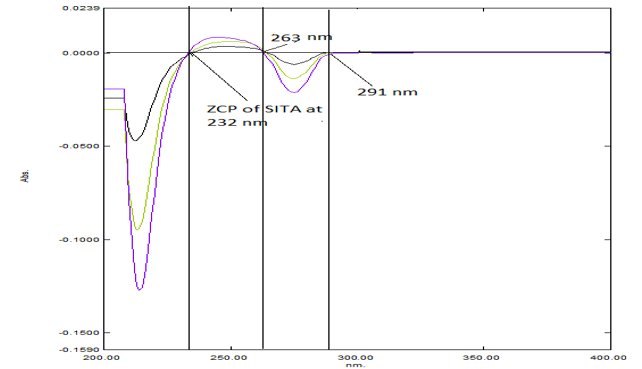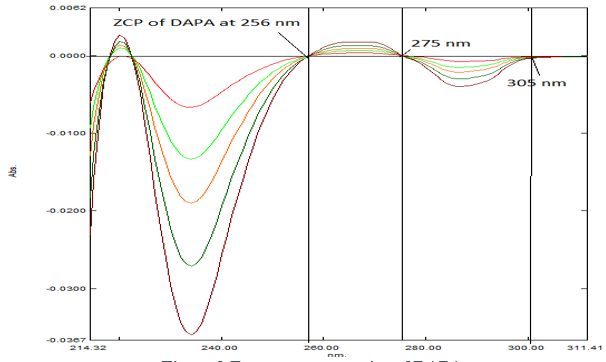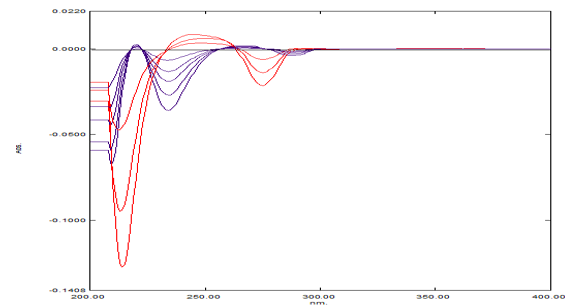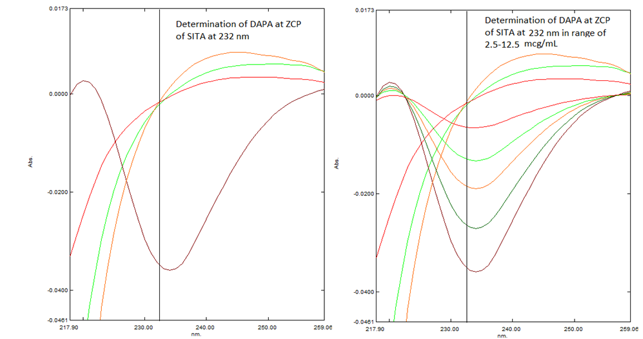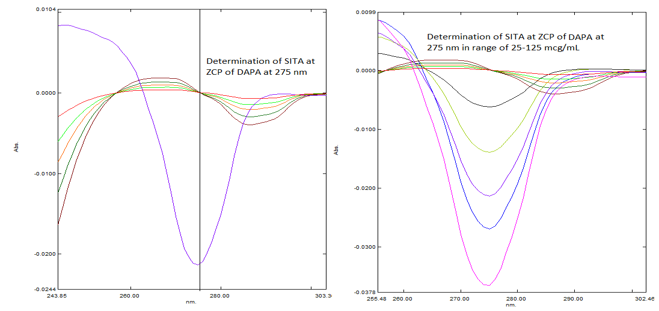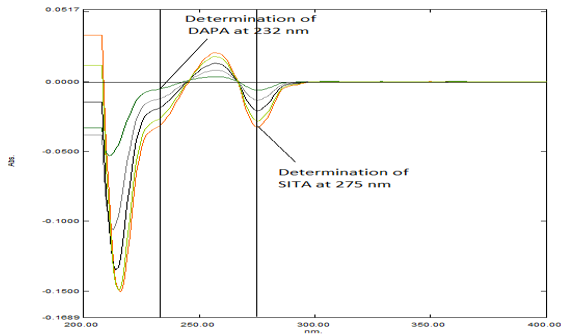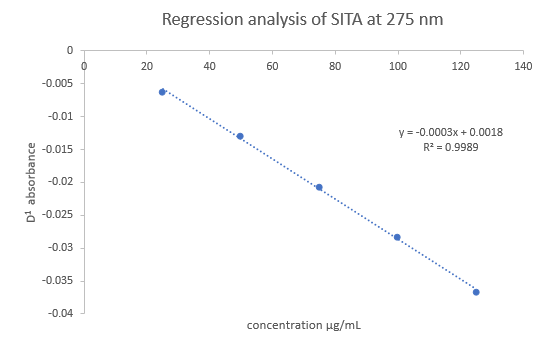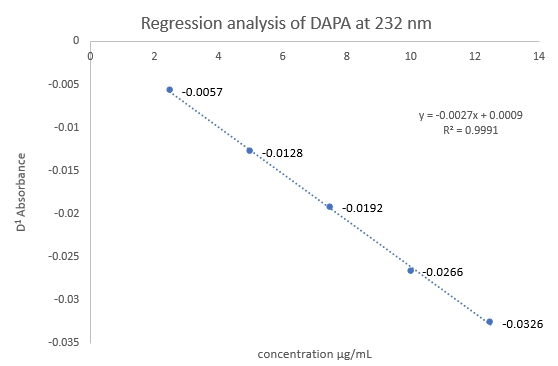Introduction
Sitagliptin (SITA) acting as Anti Diabetic agent (Dipeptidyl peptidase-4 inhibitor) which boosts post prandial insulin release, decrease Glucagon secretion and lower mean time as well as fasting blood glucose in type 2 diabetes.1 This agent is used in combination with other oral hypoglycemic agents. Dapagliflozin (DAPA) acting as Sodium-Glucose cotransporter-2(SGLT2) inhibitors. This agent is used in combination with diet and exercise to improve glycemic control in adult with type -2 Diabetes. SGLT 2 is major transporter of glucose whose inhibition induces glucosuria and lower blood sugar in type 2 diabetes mellitus.2 According to the clinical trial study of real-World Evidence with SGLT2i(DAPA) and DPP4i (SITA) in Type-2 Diabetes patients in Spain (NCT04149067)it shows beneficial positive effect on patient of Diabetes Mellitus (Type-2) at the close level of 5-10 mg of DAPA and 50-100 mg of SITA.3 Best clinical effectiveness was observed at 100 mg dose of SITA and 10 mg of DAPA and hence for method development purpose dose was selected as a mixture comprising 10 mg of DAPA and 100 mg of SITA. Several analytical methods are available which can determine SITA and DAPA individually or in combination with another drug. From detailed review of literature, it was found that no analytical method is available for determination of DAPA and SITA from simulated mixture or formulation,4, 5, 6, 7, 8, 9, 10, 11, 12, 13, 14, 15, 16, 17, 18, 19, 20, 21, 22, 23, 24 Furthermore UV spectrophotometric methods are more convenient with respect to operation in comparison with chromatographic methods of analysis. In addition, derivative spectroscopy aids virtue of specificity to the analytical method due to estimation at Zero Cross Over point (ZCP). So for the same reason derivative spectroscopy was selected as method of choice from all other multi component UV spectrometric methods.
Table 1
Preparation of solutions for accuracy studies
Table 2
Linearity data of sita
Table 3
Linearity data of DAPA
Table 4
Repeatability data of SITA at 275 nm (n= 5 determinations)
Table 5
Repeatability data of DAPA at 323 nm (n= 5 determinations)
Table 6
Intraday and inter day precision data of SITA (n = 3 determinations)
Table 7
Intraday and inter day precision data for DAPA (n = 3 determinations)
Table 8
Accuracy data of SITA and DAPA by derivative spectroscopy method
Table 9
Assay of synthetic mixture by validated 1st order derivative spectroscopic method
|
Drug |
Amount taken (µg/mL) |
Amount recovered (µg/mL) |
% Assay |
|
SITA |
125 |
124.99 ± 0.6 |
100.0 ± 0.6 |
|
DAPA |
12.5 |
12.6 ± 0.7 |
100.6 ± 0.7 |
Materials and Methods
Materials
DAPA (99.98% pure) and SITA (99.96% pure) were obtained as gift sample for research purpose from, Cadila Healthcare Ltd., Sanand. Methyl alcohol (LR grade) was purchase from S.D. fines.
Instrument and experimental conditions
Spectrophotometric analysis was performed on shimadzu UV-1800 double beam spectrophoto-meter having path length of 1 cm matched pair of quartz cells. Obtained spectra of SITA and DAPA were derivatized 1st order using UV probe 2.42 as software at delta ʎ of 10 nm
Preparation of master stock solution
For the method development purpose, 10 mg of SITA was weighed and diluted to 10 mL (1000 µg/mL) and was further diluted to give final concentration of 250 µg/mL. In similar way 50 mg of DAPA was weighed and diluted to 100 ml (500 µg/mL) and was further diluted to give final concentration of 25 µg/mL.
Selection of analytical wavelength
The working standards of SITA (25-125 μg/ml) and DAPA (2.5-12.5 μg/ml) were prepared in 10 ml volumetric flask using methyl alcohol as a solvent. They were scanned in the UV range of 200 – 400 nm and D0 spectra is recorded by UV spectrophotometer. All the D0 spectra of SITA and DAPA were transformed into D1 spectra with the help of UV probe 2.42 software. For confirmation of D1 spectra of SITA and DAPA, D0 and D1 spectra of the same were overlapped.
Preparation of solutions for analytical method validation
Preparation of solution for linearity and range
To check linearity of method, SITA was prepared in the concentration range of 25-125 µg/ml and DAPA was prepared in the range of 2.5-12.5 µg/ml from master stock solution in 10 ml volumetric flask. When D1 Absorbance was plotted against concentration, non-linearity was observed above 150 µg/ml for SITA and above 20 µg/ml for DAPA so final range for validation was selected at mixture containing 25-125 µg/ml for SITA and 2.5-12.5 µg/ml for DAPA. All prepared solutions were scanned between 200-400 nm and all spectra were derivatized to 1st order. D1 absorbance were obtained at selected wavelength and mean D1 absorbance was plotted against concentration (To get mean D1 absorbance, procedure was repeated for five times)
Method precision
Method precision was determined by performing intraday and interday precision. Mixture that represents overall range (2.5+25, 7.5+75 and 12.5+125 µg/mL) were analyzed on same day at different time interval for intraday precision. Mixture that represents overall range (2.5+25, 7.5+75 and 12.5+125 µg/mL) were analyzed on different days for interday precision.
Accuracy study
Accuracy of analytical method was adjudged by spiking of placebo with standard solution. Mixture containing 100 mg of directly compressible lactose, 2mg of talc and 2 mg of magnesium stearate was selected as placebo and was spiked at 50, 100 and 150% of target concentration (5+50 µg/mL) (Table 1). Placebo (un spiked) was analyzed at given wavelengths for any possible interference. Each spiked concentration was analyzed for three times and mean % recovery was observed at each spiked level.
Solvent stability
Solvent stability was determined by scanning the same solution prepared in selected solvent (methyl alcohol) at 3 different time interval that is at 0 hour, 6 hours and 24 hours. Mixture of 12.5+125 µg/ml solution of SITA and DAPA in methyl alcohol were scanned at selected time interval and characteristics of spectra were compared (λmax).
Assay
As the proposed synthetic mixture is having dose of 10 mg of DAPA and 100 mg of SITA, was mixed with selected placebo, and diluted appropriately to give mixture containing 125 µg/ml of SITA and 12.5 µg/ml of DAPA. This mixture was scanned between 200-400 nm and was derivatized to 1st order. D1 absorbance was measured at selected wavelengths and were transformed to concentration with help of linear regression equation. This mixture was analyzed for three times and mean % assay was drawn.
Result and Discussion
Selection of analytical wavelength
Three different ZCP at 232 nm, 263 nm and 291 nm were observed in overlain D1 spectra of SITA (Figure 1). Three different ZCP at 256 nm, 275 nm and 305 nm were observed in overlain D1 spectra of DAPA (Figure 2). For determination of analytical wavelength D1 spectra of SITA and DAPA were overlapped (Figure 3). But there is very less difference between absorbance values of DAPA at 291 nm and hence difficulty in quantifying the same. Discussed problem can be eliminated at 232 nm, where the D1 absorbance values of DAPA are linear with significant difference (Figure 4). In similar way at ZCP of DAPA, linearity was observed only at 275 nm for SITA (Figure 5). So 232 nm and 275 nm were selected as analytical wavelength for quantitative determination of DAPA and SITA respectively.
Linearity and range
When D0 spectra of SITA was taken between 25 - 150 µg/mL, non-linearity was observed over 150 µg/mL. So, linearity for SITA was observed between 25 - 150 µg/mL. for method development purpose range was selected between 25 - 125 µg/mL (based on beer — lambert’s law). In similar way D0 spectra of DAPA was taken between 2.5 - 20 µg/mL, but non-linearity was observed over 20 µg/mL. So, linearity for DAPA was observed between 2.5 - 20 µg/mL. and for method development purpose range was selected between 2.5 - 12.5 µg/mL (based on beer — lambert’s law). So final range for validation was selected at mixture containing 25 - 125 µg/ml for SITA and 2.5-12.5 µg/ml for DAPA (Figure 6). When calibration curve was plotted for given concentration range (Figure 7, Figure 8), value of linear regression coefficient was found to be 0.9989 for SITA and 0.9991 for DAPA. Regression equation was found to be y = 0.0003 X + 0.0018 for SITA and y = 0.0027 X + 0.0009 for DAPA. Linearity data for both drugs is shown in Table 2, Table 3
Repeatability
When all mixtures were analyzed at all concentration, calculated relative standard deviation at each level was found to be less than 2 so that method was found to be repeatable over the range of 25 - 125 µg/ml for SITA and 2.5 - 12.5 µg/ml for DAPA. Repeatability data are shown in table 4 and 5 for SITA and DAPA respectively.
Method precision
For determining inter day and intraday precision, % RSD was monitored at selected concentration level which was found to be less than 2 so method was found to be precise for estimation of SITA and DAPA. Data for intermediate precision are given in Table 6, Table 7 for SITA and DAPA respectively.
Accuracy study
Spiked placebo with standard solution at 50, 100 and 150% level was analyzed for % recovery which was found within 98 to 102, so method was found to be accurate (Table 8).
Solvent stability
As the λmax was stable over period of 24 hrs, the solvent was found to be suitable and drug was found to be stable.
Assay
When prepared synthetic mixture was analyzed by developed and validated method, % assay was found to be 100.0 ± 0.6 for SITA and for 100.1 ± 0.7 DAPA (Table 9)
Summary and Conclusion
The 1st order derivative spectroscopic method was developed and validated as per ICH Q2 R1 guidelines and was successfully applied for determination of SITA and DAPA from its synthetic mixture. Present method was found to be economical in terms of cost and time. Commonly used excipient didn’t interfere in estimation of SITA and DAPA so method was found to be specific. Method was also found to be repeatable and precise.
Acknowledgment
Authors are extremely grateful to Cadila Healthcare Ltd. for providing gift sample of DAPA and SITA without them this work would not have taken place. We are also thankful to overall research team who have contributed in either of the way. The authors are also grateful to Smt. S.M. Shah Pharmacy College for providing excellent research facilities and promoting research activities.
Author contributions
Shivani Jani- Collection of all the data after the completion of the research work and the preparation of manuscript was done by Shivani Jani.
Rashmi Shukla- After designing the project, execution of project was carried out by Rashmi Shukla.
Pinak Patel- The design of the study from choosing the drug to choosing the method was done by Pinak Patel.
Binny Mehta- After completion of the study, analysis of the data obtained from UV was done by Binny Mehta.
Krunal Detholia- During the study, synthetic mixture preparation according to the dose of the drugs was done by Krunal Detholia.

